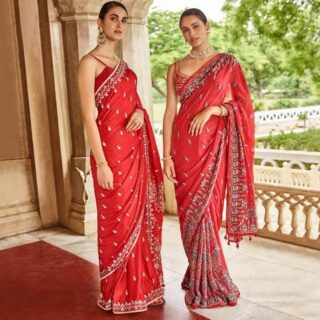The design of a sari is a very important part of the dress, and some more functional designs are more popular than others. Let’s take a look at the most popular red sarees and their pros and cons.
Contents
5-yard saree
This is the most popular, with vast stretches of fabric that can be worn in many different ways. The only downside to this style is that it can be heavier than other styles because there are so many layers to it. You can buy it from Snapdeal
Left-saree
This is a popular design that has the material on one side and the ends on the other so you can wear it in different ways. It’s also better for those who want to use their saris within a week.
2-yard saree
This is very easy to work with, and it’s available in a variety of bright colors with no buttonholes. It is also a relatively heavy sari and therefore may not fold as neatly as the left sari.
3-yard saree
This is lightweight and has a lot of material on the sides so that it can be wrapped around you while you sit down. Generally, it’s best for those who do not plan to use their saris that often but need something classic to wear to weddings and parties.
6-yard saree
This is a heavy sari that can be used for daily activities such as going to the market or bathing. However, because it has long ends that are not tucked into the center, it needs to be folded at least twice, and sometimes three times, before you can use it.
8-yard saree
This is a long, heavy piece of fabric that can be used in many different ways. It also has more of a rectangular shape than the 5-yard sari, which is a plus if you’re using it for weddings and other special events where you want to fold the ends and tuck them into the center.
The half-saree
This is a half-yard of material that can be folded in half and worn, which makes it much lighter than the full sari. It is also an ideal choice for those who don’t like to fold and unfold their saris too often.
The satin saree
Satin means that the material has a shiny finish, which makes it difficult to see the design when you’re wearing it. But because satin can be made from fine materials, it can be used to create a beautiful sari that conceals the design seamlessly.
Dupatta saree
This is another popular item in an Indian woman’s wardrobe. It is a scarf that is wrapped around the waist and draped over the shoulder so that it looks like a sari. The best kind of dupatta has polyester or cotton woven into it, which makes it easy to tie around your neck when you don’t want to wear a sari.
The shalwar kameez
This is a skirt that you would wear under your sari or kurta so that it looks like part of the outfit. It can be bought from India and traditional clothing shops, but it can also be made easily by following instructions you find online.
Saree-Traditional One
A Saree is a piece of cloth about 6-meter long and 2–2.5 cm wide that is worn by Indian women in the country India, which is used as both a women’s traditional attire and as female formal wear for gatherings and events. A sari consists of a drape varying from 5 to 9 yards (4.6 m to 8.2 m) long held by a sari-kanga usually made from cotton, silk, or polyester. It has some folds at the bottom of the drape and is normally draped so that it falls gracefully from the shoulders to the floor. Each fold is referred to as a daan (plural dain) and has many variations including Sarkari, Nathdwara, rajwada, and bhagwa which have specific meanings.
Women love to wear saree
A sari is usually worn over a petticoat, with a fitted blouse piece called a choli. Some people also wear a short-sleeved or sleeveless top over it, but usually, the sari covers from just under the bust to the ankles or floor. A drape forms the lower part of the sari and is referred to as panache. It is normally about 3-4 ft long and about 1.5″ to 1.75″ wide, and is composed of a middle piece called an Aparna, held on by a band of cloth called the Nath, that constricts it into a tube. A chiffon shawl or doli is often tied around the lower part of the sari to make it more delicate and low-cut. This is often done only at festivals or special occasions such as weddings where there are many women gathered in one place, and sometimes includes a small piece of colored fabric tied on top. This is tied on so that it can be draped over the upper part of someone’s shoulder. The drape may also be tied around the waistline, but only in a formal style, and a petticoat rather than one’s own underwear is usually worn underneath.
Steps to follow to round up the saree
There are several step-by-step ways of wearing a sari. It may be worn in 5 different ways: “Ajamada Pranali”: In this style, the pallu is pulled back over the left shoulder and draped around the waist. The right side of the sari is pleated and worn over the left shoulder with its ends tucked in at the waist. The pleats are created by making a series of small pleats as one tuck in at the end of the pallu. The drape is worn over the petticoat. The end of the pallu is often tucked in to make a series of knots. This style can be used for any formal occasion.
Ajamada Karnataka Pranali
“Ajamada Karnataka Pranali”: In this style, first the right side of the sari is pleated, and then it is draped around the waist with its end hanging on one’s left hip and tucked into the waist. The pallu is draped around the neck with the left shoulder bared and pinned in place. “Ajamada Nahali”: This style is similar to the previous one, except that the pallu is not confined by anything. The pallu is draped around one’s left shoulder with its end tucked in at the waist. The drape may be worn over a petticoat or undergarments. “Ajamada Sadan”: This style of wearing a sari is seen only inside temples or during religious festivals, and it is considered to be very formal.
Conclusion
A sari is woven from fine material like silk or cotton and has a symbolic meaning. It teaches us to accept our lot in life too, whether it be at birth or later on in life. Each drape is said to symbolize one of the five elements, depending on the color of the fabric.





More Stories
Advantages and Limitations of Using Canva For Beginners
5 Advantages of Hippie Pants
How to Become a Fashion Designer